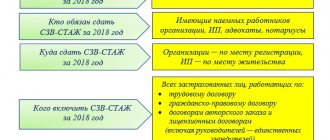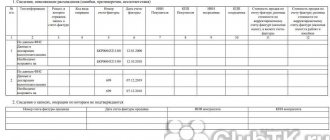Introductory information
General provisions regarding changes in the calculation of RSV-1 are contained in Article 17 of Federal Law No. 212-FZ dated July 24, 2009 (hereinafter referred to as Law No. 212-FZ). The rules for drawing up and submitting updated calculations are directly spelled out in the Procedure for filling out the RSV-1 form, approved by Resolution of the Pension Fund of the Russian Federation of January 16, 2014 No. 2p (hereinafter referred to as Resolution No. 2p). Since August 7, 2015, this Procedure has been in effect in the wording approved by Resolution of the Pension Fund Board of June 4, 2015 No. 194p (hereinafter referred to as Resolution No. 194p). However, in practice, the new rules have been applied since June 29, 2015, when the Pension Fund of the Russian Federation updated its verification program. The application of these documents raises numerous questions. In what case do you need to submit a “clarification” on contributions, and what errors can be corrected in current reporting? What form should I use to make an updated calculation? What is the procedure for making clarifications? Can a “clarification” get rid of a fine? Let's figure it out.
When is it necessary to submit an updated calculation?
There are two ways to correct errors and inaccuracies made when preparing the RSV-1 calculation. The policyholder can submit an updated calculation for the period in which errors were made, or take them into account when preparing the calculation for the current reporting period. Which method should be used in this or that situation?
If the policyholder himself reveals the error
Law No. 212-FZ provides for the only case when the policyholder is required to submit an updated calculation. This must be done if the accountant independently discovered errors or distortions in the initial calculation that led to an underestimation of the amount of contributions payable. If the error resulted in an overpayment of premiums or did not in any way affect the amount of premiums payable, then the policyholder has the right, but not the obligation, to submit an updated calculation (Part 1 and Part 2 of Article 17 of Law No. 212-FZ).
At the same time, according to the current Procedure for filling out the RSV-1, the policyholder may not submit an “update” for previous periods, but recalculate contributions in the current reporting period. Moreover, even if the errors he identified led to an underestimation of the amount of contributions. To do this, you need to reflect the additional accrued amount of contributions for previous periods in line 120 of section 1 and in section 4 of the DAM-1 calculation for the current period (clause 3, 7.3, 24 of the Procedure for filling out the DAM-1). You will also have to clarify individual information for employees (submit sections 6 of the calculation with the adjustment type “corrective” or forms SZV-6, if periods before 2014 are being specified). Unfortunately, the Procedure for filling out RSV-1 does not clearly state in what situations it is necessary to recalculate contributions in the current reporting period.
Expert of the “Kontur.Otchet PF” service Elena Kulakova (on the “Accounting Online” forum she writes under the nickname KEGa) believes that this option is more suitable for adjusting data for previous years. But it is better not to use it to correct errors in accrued contributions for previous reporting periods of the current year. After all, if the policyholder in such a situation reflects the additional accrued amount of contributions for previous periods in line 120 of section 1 and in section 4 of the calculation for the current period, then the data in column 3 of subsection 2.1. “Total since the beginning of the billing period” will differ from the organization’s accounting data. Therefore, to correct errors for previous reporting periods of the current year, it is preferable to submit an updated calculation.
If you need to adjust the database, but there was no error
If the policyholder himself has determined that it is necessary to adjust the base for insurance premiums, but he has not made any errors in calculating premiums, then there is no need to submit an updated calculation. In such a situation, according to the current Procedure for filling out the RSV-1, the necessary changes must be made to the calculation for the current reporting period. Section 4 of the calculation is intended for this (for an example of filling out this section, see the article “New form RSV-1: features of filling out and submitting the calculation for the first half of 2015”).
If the error is detected by the inspectors
If, during the check of the RSV-1 calculation, inspectors from the Pension Fund of Russia unit identified an error that resulted in underpayment of contributions, they do not have the right to require the policyholder to submit an updated calculation. Additional insurance premiums accrued based on the results of the audit must be reflected on line 120 of section 1 and in section 4 of the RSV-1 form for the next reporting period. In addition, for employees for whose benefits the inspectors have accrued additional contributions, it is necessary to provide corrective personal accounting information as part of the DAM-1 for the period in which the decision was made based on the results of the inspection.
Checking the correctness of filling out the calculation of insurance premiums based on control ratios
In order to avoid errors and inconsistencies in the calculation of insurance premiums, you should check the correctness of its completion using Control Ratios.
Such Control ratios are indicated in Letters of the Federal Tax Service of Russia dated December 13, 2017 N ГД-4-11/25417 and dated December 29, 2017 N ГД-4-11/ [email protected] , and are also given in the Appendix to the Letter of the Federal Tax Service of the Russian Federation dated June 15, 2017 N 02-09-11/04-03-13313. The calculation is completed correctly if all the equalities listed in the control ratios are met.
In what form should the updated calculation be submitted?
The updated calculation is submitted in the form that was in force during the billing period for which changes are made (Part 5, Article 17 of Law No. 212-FZ). So, if an accountant identifies an error in the calculation for the first quarter of 2015, then the “clarification” should be drawn up according to the RSV-1 form, which was in force in the first quarter of 2015 (approved by Resolution No. 2p). And if, for example, you need to correct the individual information of the insured persons for the years 2010-2013, then you will have to fill out the “old” forms SZV-6-1, SZV-6-2 or SZV-6-4 and accompany them with the corresponding inventories (clause 17.9 Procedure for filling out RSV-1).
Let us separately dwell on the question of what form to use to draw up an updated calculation for the first half of 2015. Let us recall that during the reporting campaign for the half-year there was confusion with the RSV-1 forms (for more information, see “New RSV-1 form: features of filling out and submitting calculations for the first half of 2015”). Before August 7, 2015, when Resolution No. 194p came into force, which approved the new form RSV-1, many policyholders managed to report using the “old” form in force at that time. What form should be used in this case to clarify the calculation for the half-year? If we are guided by Part 5 of Article 17 of Law No. 212-FZ, then the updated calculation must be submitted in the “old” form (that is, in the same form in which the primary calculation was submitted). However, we do not rule out that the territorial bodies of the Pension Fund of the Russian Federation may require the submission of “clarifications” for the first half of the year using the new form, since Resolution No. 194p applies “starting with the submission of calculations for the first half of 2015.” In this regard, if the policyholder reports “on paper”, then it is better to check in advance with your Pension Fund department about what form to use to draw up the “clarification”.
If the policyholder submits payments electronically, then there should be no problems with choosing the form. In modern web services for preparing and submitting reports (for example, in the Kontur.Extern service), the program will automatically generate updated reports in the required format, which will be accepted by the fund without refusal. The accountant will only need to enter the correct data into the form provided by the service.
Filling out the updated calculation
The general principle for filling out the updated RSV-1 calculation is as follows: it must include not only the corrected data, but also all other indicators of the form, including those that were initially correct. Next, we will consider some of the features of filling out the updated calculation, compiled according to the form that has been in effect since August 7, 2015.
Title page
In the “Adjustment number” field, you must indicate which account updated estimate is being submitted. If the primary calculation is corrected for the first time, then the clarification number will be 001, the second time - 002, etc.
In the “Reason for clarification” field, one of the following codes is entered (clause 5.1 of the Procedure for filling out the RSV-1): “1” - indicators relating to the payment of pension contributions (including additional tariffs) are specified; “2” - the amounts of accrued pension contributions are changed (including at additional tariffs); “3” - clarifications relate to medical premiums or other indicators that do not affect individual accounting information for insured persons.
Please note: if accrued and paid pension contributions are simultaneously updated, it is also necessary to adjust individual information for insured persons. In this case, the code “2” should be entered in the “Reason for clarification” field. By indicating this code, the policyholder notifies the Pension Fund of the Russian Federation that the updated calculation includes adjusted individual information for employees.
Sections 1 and 2
These sections in the updated calculation are filled out according to the same rules as in the initial calculation (except for subsection 2.5.). Sections 1 and 2 of the updated calculation must be compiled again, indicating the correct (corrected) data. There is no need to explain the differences compared to the original calculation.
Regarding subsection 2.5. “Information on packs of documents containing the calculation of the amounts of accrued insurance premiums in relation to insured persons”, it is filled out by policyholders who have entered personalized information in sections 6 of the calculation. Let us remind you that sections 6 of the calculation are formed into packs. The list of packages containing personalized information is reflected in subsection 2.5. Therefore, if, as part of the clarification, the number of sections 6 of the calculation changes, then the content of subsection 2.5 will also need to be changed. (see below for more on this).
Section 3
This section of the calculation is filled out by policyholders who have the right to apply reduced insurance premium rates in accordance with Article 58 of Law No. 212-FZ. For example, subsection 3.2. Section 3 is intended for organizations and entrepreneurs on the simplified tax system who are engaged in “preferential” types of activities, and, accordingly, can pay contributions at a reduced rate (clause 8, part 1, article 58 of Law No. 212-FZ). If when filling out subsection 3.2. If the accountant made a mistake in the initial calculation, then in the updated calculation you need to fill out this subsection again, indicating the correct information.
Section 4
Section 4 of the calculation reflects the amounts of recalculation of insurance premiums from the beginning of the billing period. We are talking about the amounts that the policyholder must pay extra based on the decision of the Pension Fund of the Russian Federation, or in the event of an independent discovery of an error that led to an underestimation of the amount of contributions. In addition, this section is filled out if the policyholder himself has identified that it is necessary to adjust the base for insurance premiums, but has not made any errors in calculating contributions (clause 24 of the Filling Out Procedure).
However, when filling out the updated calculation, no new information needs to be entered into section 4. This section can be included in the adjusted calculation only if this section was filled out in the primary calculation for the adjusted reporting period. In such a situation, the data from section 4 of the primary calculation is simply transferred to the same section of the updated calculation.
Section 5
This section is filled out by organizations that pay remuneration to students for activities carried out in the student team under employment or civil contracts. If it is necessary to correct the content of section 5, then in the updated calculation this section must be filled out again, reflecting the correct indicators.
Section 6
Starting from reporting for the first quarter of 2014, individual accounting information for insured persons is presented as part of the DAM-1 calculation. For this purpose, the calculation form contains Section 6 “Information on the amount of payments and other remunerations and the insurance period of the insured person.” The procedure for clarifying this section raises a large number of questions. Therefore, let us dwell on the features of clarifying individual (personalized) accounting information in more detail.
Mistake #1
For organizations NOT located in the regions of the pilot project (credit system), line 070 of Appendix 2 to Section 1 Expenses incurred for the payment of insurance coverage . The amount of social insurance expenses is also not taken into account when calculating the indicators of line 090 of Appendix 2 to Section 1 and lines 110-113 of Section 1 .
This bug is registered under number 30171688 and is fixed in releases 3.1.13.120 and 3.1.10.348.
Clarification of individual accounting information
Since August 7, 2015, the following rules for clarifying personalized accounting information have been in effect (clause 5.1 of the Procedure for filling out the RSV-1):
- if the updated calculation is submitted before the deadline for submitting the RSV-1 for the next reporting period, then the corrected individual accounting information is presented with the “initial” adjustment type (that is, as if the information was submitted for the first time);
- if the error is corrected after the deadline for submitting the RSV-1 for the next reporting period, then individual accounting information with the type of adjustment “corrective” or “cancelling” must be presented as part of the calculation for the current period, and not the adjusted calculation.
Thus, in order to choose the right course of action, it is necessary to determine the deadline for submitting the RSV-1 for the next reporting period. Let's explain with an example. Let’s assume that the policyholder needs to clarify the accounting information presented as part of the RSV-1 form for the first half of 2015. The reporting period following the half-year is the nine months of 2015. The deadline for submitting reports for the nine months of 2015 is October 1, 2015. This date is the desired “due date for the RSV-1 for the next reporting period.” In our example, this means that the updated calculation for the first half of 2015 with section 6 with the “original” adjustment type must be submitted no later than October 1 of this year.
Let us recall that previously the Pension Fund of Russia recommended its subordinates to accept updated calculations with the “initial” adjustment type until the 1st day of the third calendar month following the reporting period. After this, it was proposed to clarify the persucheta data in calculations for the next reporting period (see “PFR branches will accept the updated RSV-1 within two months from the end of the reporting period”). If we adhere to this clarification from the Pension Fund, then the accounting calculation for the first half of 2015 should have been submitted no later than September 1, 2015. Thus, the current version of clause 5.1 of the Procedure for filling out the RSV-1 gives policyholders more time to correct individual information with the “initial” adjustment type.
Now let’s look at the rules for clarifying persuance information. As mentioned above, the procedure depends on when the accountant identified the error and, accordingly, when he plans to correct it.
The accountant identified the error before the deadline for submitting RSV-1 for the next reporting period
On September 8, 2015, the organization’s accountant discovered that in the RSV-1 form for the first half of 2015, the amount of accrued pension contributions for one of the employees was underestimated. The deadline for submitting accounts for nine months (October 1, 2015) has not yet arrived. This means that to correct the error, the accountant can submit a “clarification” (deadline - until October 1, 2015). To clarify individual information regarding this employee, you need to enter the correct data in Section 6 of the updated calculation and select the “initial” adjustment type (o). Fill in the fields “Reporting period” and “Calendar year” in subsection 6.3. no need.
In addition, when drawing up an updated calculation you need:
- in subsection 6.4. “Information on the amount of payments and other remuneration accrued in favor of individuals” correct the amount of payments in favor of the employee and the base for calculating contributions;
- in subsection 6.5. “Information on accrued insurance premiums” reflect the correct amount of accruals;
- in subsection 6.6. “Information on corrective information” transfer data from the corresponding subsection of the primary calculation (if subsection 6.6. was filled out in the primary calculation);
- in subsection 6.7. “Information on the amount of payments and other remuneration in favor of an individual employed in the relevant types of work” correct the amount of payments from which contributions are paid at additional tariffs;
- in subsection 6.8. “Period of work for the last three months of the reporting period”, adjust information about the length of service (if required).
In a similar way, you need to draw up sections 6 (with the “initial” adjustment type) for all employees for whom the accountant underestimated the amount of insurance premiums, and include these sections in the adjusted calculation of RSV-1. In addition, the updated calculation must be supplemented with sections 6 for employees in respect of whom no errors were made. Information on such employees is transferred from section 6 of the primary calculation to section 6 of the updated calculation without changes.
We also note that when clarifications are made to the persuance accounting information, the number of sections 6 of the calculation may change (for example, due to the appearance of new sections 6 with the “initial” adjustment type for employees who were “forgotten” when preparing the initial calculation). Accordingly, the number of packs containing personalized information may also change. Data on reformatted packs should be reflected in subsection 2.5.1. updated calculation.
The accountant discovered an error after the deadline for submitting RSV-1 for the next reporting period
On October 5, 2015, the organization’s accountant discovered that in the RSV-1 form for the first half of 2015, the amount of accrued pension contributions for one of the employees was underestimated. The deadline for submitting calculations for nine months (October 1, 2015) has already arrived. In this case, the corrected individual information (section 6) should be included in the DAM-1 calculation for the current reporting period (that is, in the calculation for 9 months of 2015).
To do this, in subsection 6.3. You need to enter the “Adjusting” field and indicate the reporting period. This should be the period during which the error is corrected. The “Calendar Year” should also be indicated. The field “Registration number in the Pension Fund during the adjusted period” is not filled in if the policyholder has not changed the registration address and registration number.
When filling out the remaining subsections of Section 6 of the updated calculation, you must adhere to the following rules:
- in subsection 6.4. “Information on the amount of payments and other remuneration accrued in favor of individuals” must indicate the correct amounts of payments;
- in subsection 6.5. “Information on accrued insurance premiums” you need to show the correct amount of accrued premiums;
- in subsection 6.6. “Information on corrective information” should be transferred from the corresponding subsection of the primary calculation (if subsection 6.6. was filled out in the primary calculation). No corrections need to be made to this subsection;
- subsection 6.7. “Information on the amount of payments and other remuneration in favor of an individual employed in the relevant types of work” must be filled out if contributions for additional tariffs were also underestimated;
- subsection 6.8. “Period of work for the last three months of the reporting period” must be completed, since the information contained in section 6 with the adjustment type “corrective” replaces the information about the length of service loaded from the primary calculation on the employee’s personal account.
Thus, the RSV-1 calculation for the current reporting period must include sections 6, which contain information on all employees for a given reporting period (with the “initial” adjustment type), as well as sections 6 with the “corrective” adjustment type in relation to employees for whom information for the previous period is being updated.
Note that the type of information correction can be not only “initial” or “corrective”. If the payer needs to completely cancel previously submitted information about the employee, then the “cancelling” adjustment type is used. This is possible if, for example, the payment was erroneously accrued to a dismissed employee. In section 6 of the RSV-1 calculation with the “cancelling” adjustment type, subsections 6.1.- 6.3. are filled in, and in column 3 of subsection 6.4. the category code of the insured person is indicated (according to Appendix No. 2 to the Procedure for filling out the DAM-1 calculation). The remaining subsections of Section 6 should be left blank.
Please note: if an error in individual information affected the total amount of contributions, then before submitting the DAM-1 for the current period (in our example - for 9 months of 2015), it is advisable to submit an updated calculation for the period in which the error was made (in our example - for the first half of 2015). The Pension Fund of Russia division will receive in advance an updated calculation with new (correct) amounts and will correct the information in its databases. By this, the policyholder will protect himself from possible claims from fund employees when accepting and checking current reports. In this case, individual information (sections 6 and subsections 2.5.) does not need to be included in the updated calculation. After all, the accountant will make all adjustments for employees as part of the current calculation with the adjustment type “corrective” or “cancelling”.
Payment of arrears and penalties
Submission of an updated calculation exempts from a fine for non-payment of contributions if the conditions listed in paragraph 1 of part 4 of article 17 of Law No. 212-FZ are met. Firstly, clarifications must be submitted before the moment when the policyholder learned that inspectors from the Pension Fund of the Russian Federation had identified an understatement of the taxable base, or that they had ordered an on-site inspection. Secondly, even before submitting the “clarification”, the policyholder must pay the missing amount of insurance premiums and the corresponding penalties. The amount of penalties payable is calculated based on 1/300 of the refinancing rate of the Central Bank of the Russian Federation, valid for each day of delay (Part 6, Article 25 of Law No. 212-FZ). If this is not done, the organization will be subject to a fine of 20% of the amount of contributions not paid on time (Clause 1, Part 4, Article 17, Part 1, Article 47 of Law No. 212-FZ).
Thus, if the policyholder has identified an error that led to an underestimation of the amount of premiums payable, it is safer to immediately provide an “adjustment” and pay additional premiums. If the policyholder decides to recalculate contributions in the current reporting period, then it is possible that inspectors from the Pension Fund of the Russian Federation will have time to identify errors, add additional contributions and hold him accountable for non-payment of contributions. We also note that controllers will not be able to make any claims against the policyholder for the very fact of failure to submit an updated calculation if all the necessary amounts are paid.
Responsibility for violation of the deadline and method of submitting Calculation of insurance premiums
Penalties are provided for violation of the deadline and method for submitting calculations for insurance premiums. Violation of the deadline for submitting the calculation entails the following consequences:
- a fine in the amount of 5% of the unpaid (underpaid) amount of contributions specified in the calculation for each full and partial month of delay, but not more than 30% of this amount and not less than 1,000 rubles. (Article 119 of the Tax Code of the Russian Federation);
- a fine of 1,000 rubles, if at the time of submitting the calculation, insurance premiums have been paid in full;
- warning or administrative fine in the amount of 300 to 500 rubles. — for officials of the organization (Article 15.5 of the Code of Administrative Offenses of the Russian Federation);
- blocking of an account due to late payment of contributions and suspension of electronic money transfers. Consequences will occur if the calculation is not submitted within 10 working days after the deadline for its submission (clause 6 of article 6.1, clause 3.2 of article 76 of the Tax Code of the Russian Federation).
The fine must be calculated separately for each type of compulsory social insurance (letter from the Federal Tax Service of Russia dated 06/30/2017 N BS-4-11/ [email protected] , dated 05/05/2017 N PA-4-11/8641).
A fine of 1,000 rubles. distributed to the budgets of state extra-budgetary funds in the same proportion as the rate of insurance contributions of 30% for certain types of compulsory social insurance (Article 425 of the Tax Code of the Russian Federation, Letter of the Federal Tax Service of Russia dated June 30, 2017 N BS-4-11 / [email protected] ) .
For example, for organizations that pay income to individuals, the distribution of the fine looks like this:
- 22%, that is, 22 / 30 × 1,000 = 733.33 rubles. - on the OPS;
- 5.1%, that is, 5.1 / 30 × 1,000 = 170 rubles. - on compulsory medical insurance;
- 2.9%, that is, 2.9 / 30 × 1,000 = 96.67 rubles. - at VNiM.
The fine must be transferred in three different payments to the appropriate KBK.
For violation of the method of submitting a payment, namely submission on paper, if the payer is required to submit it in electronic form, a fine of 200 rubles is provided. (Article 119.1 of the Tax Code of the Russian Federation).









